How to grow annual geraniums — also known as pelargoniums — including watering, pruning and taking cuttings for new plants. A complete geranium care guide!
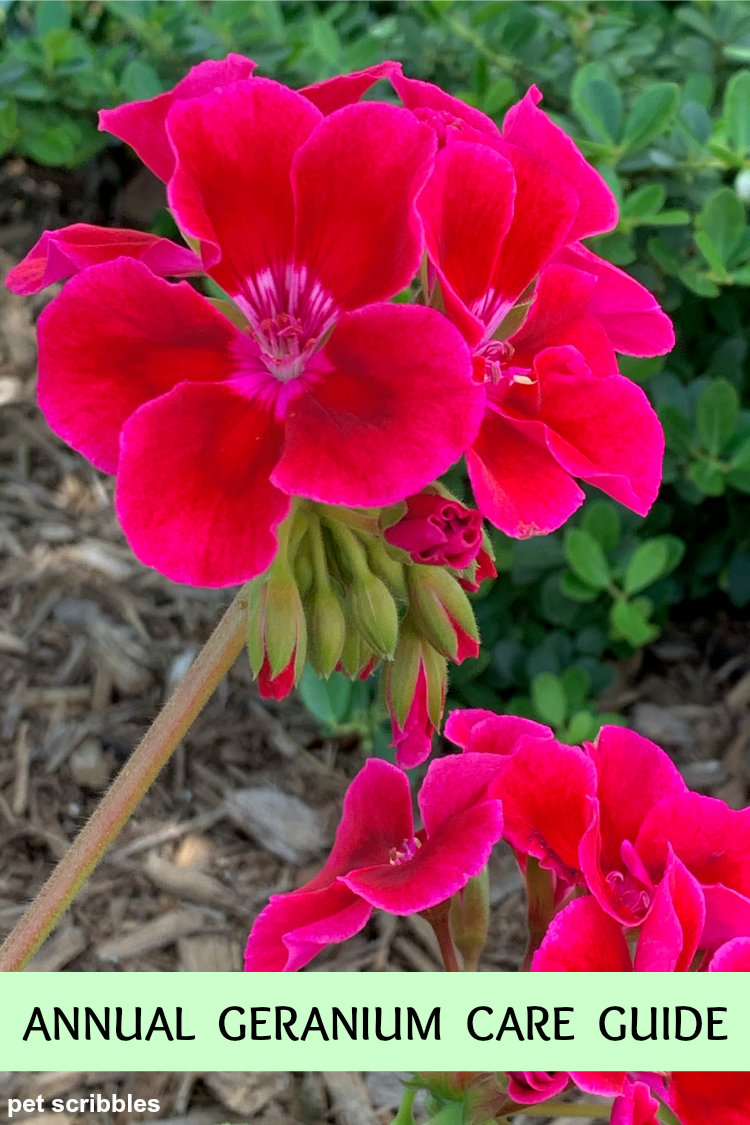
One of my fondest memories is when I was a young child taking piano lessons, and the wonderful woman teaching me had a giant picture window where she placed all her plants in the Winter time, including her geraniums. It was always a magical site to me, as every plant rested on a china dish or a ceramic bowl — each one prettier than the next!
I can still picture everything so vividly. Maybe that’s what started my love of geraniums at an early age!
Table of Contents
- Why I added annual geraniums into our garden beds
- My love for simple annual geraniums
- Are geraniums annual or perennial plants?
- A short history about geraniums
- Do annual geraniums come back every year?
- Do geraniums bloom all Summer?
- Are geraniums resistant to deer, rabbits and squirrels?
- Annual geranium colors
- Do geraniums prefer sun or shade?
- Annual geraniums — watering requirements
- Annual geraniums — too much water
- Best fertilizer for geraniums
- How to deadhead geraniums
- Pruning geraniums
- How to grow annual geraniums from seed
- How to grow annual geraniums from cuttings
- Winter care for annual geraniums
Why I added annual geraniums into our garden beds
When I attended the 2019 Philadelphia Flower Show a few months ago, I was almost overwhelmed with the amount of planting combinations and garden ideas there.
I tried my best to condense what I liked most into a blog post so you could get a sense of what I experienced: Garden Ideas from the 2019 Philadelphia Flower Show.
One of the sections in that blog post was about zonal geraniums, also commonly called annual geraniums. I wrote,
After taking in so many unusual plants and flowers, it was refreshing to see a display with annual Geraniums!
Note to self: Don’t just put these guys in containers — pop a few into the ground.
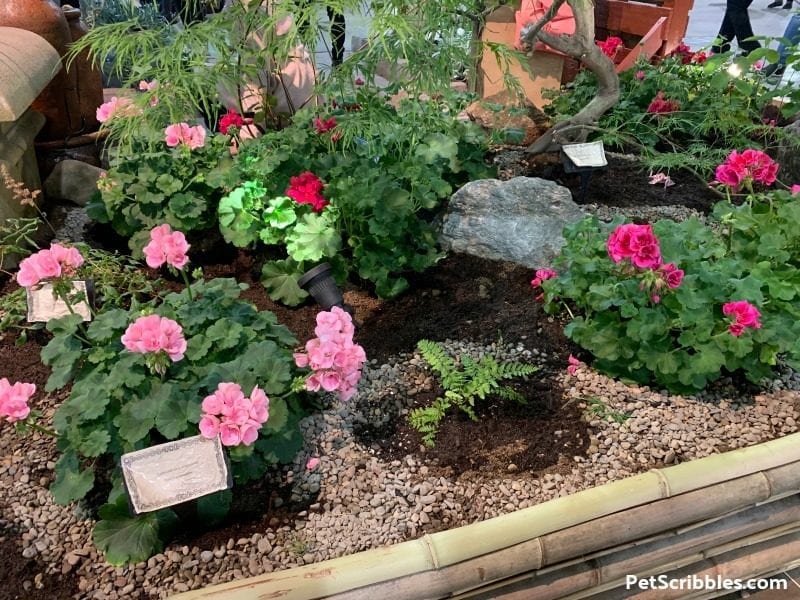
Well, I’ve gone and done just that: planted several annual geraniums in our garden beds, in addition to the usual containers I plant as well.
Inspired by the ones I photographed up close at the Philadelphia Flower Show . . .
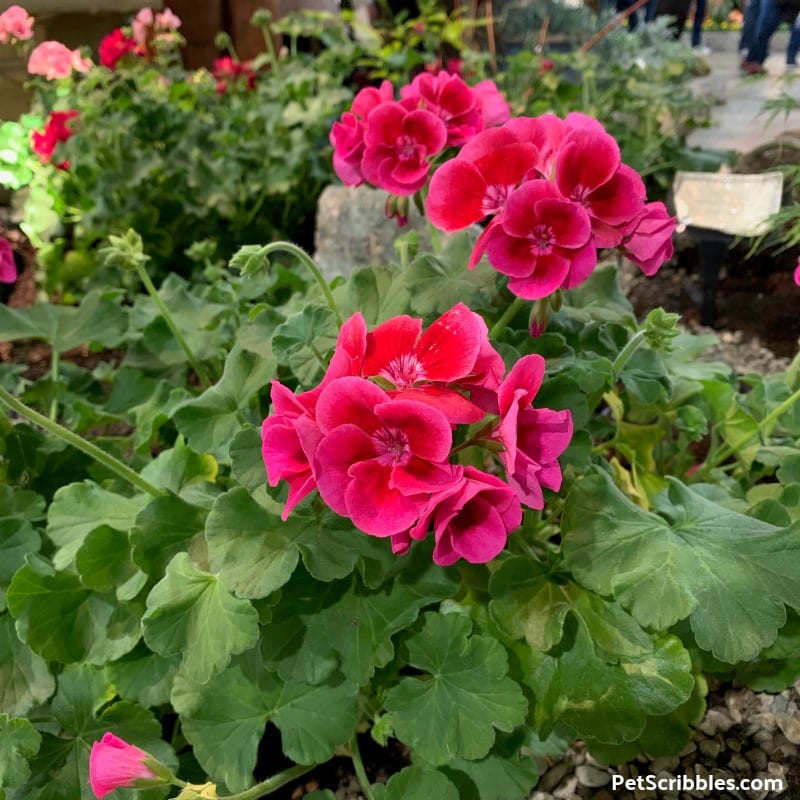
. . . I went hunting for something similar in color to plant.
I found these at a small, local nursery:
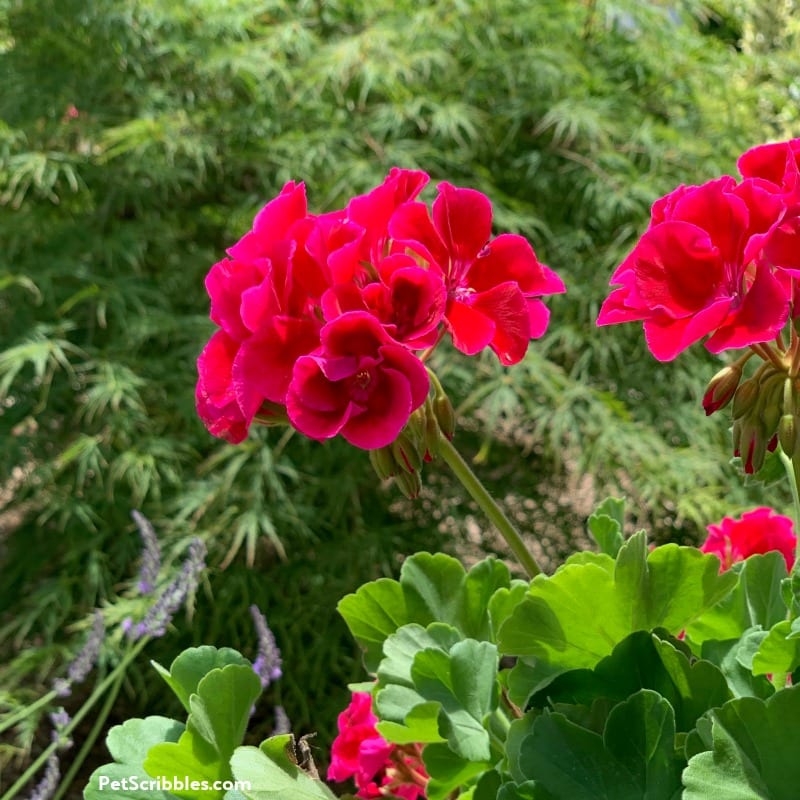
They’re called a hybrid geranium, specifically: Calliope Medium Crimson Flame.
My idea was to plant geraniums that had the exact color of our Knock Out Roses so that I could continue that color throughout our garden beds.
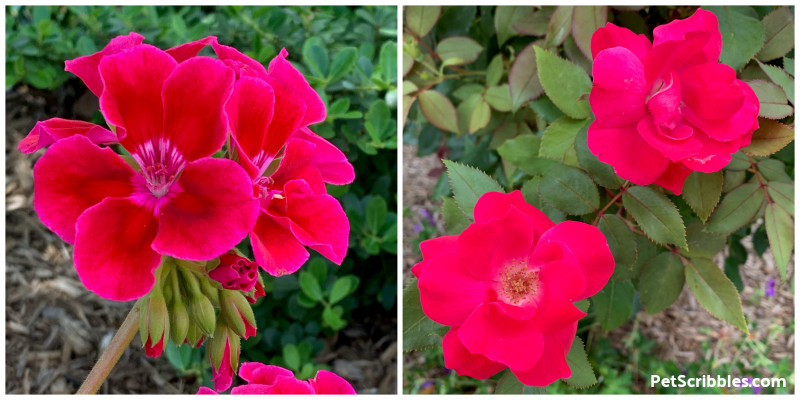
I think I nailed it! And my husband noticed the exact color match right away — always a good thing, right?
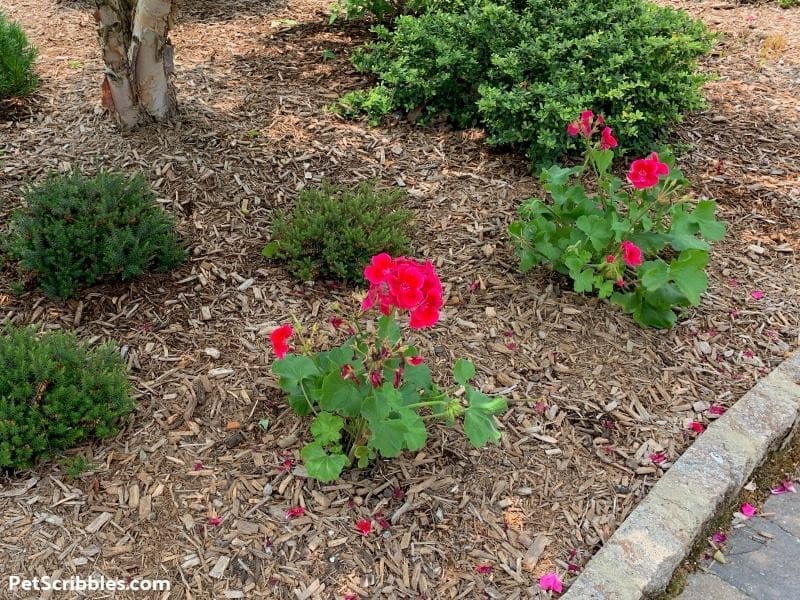
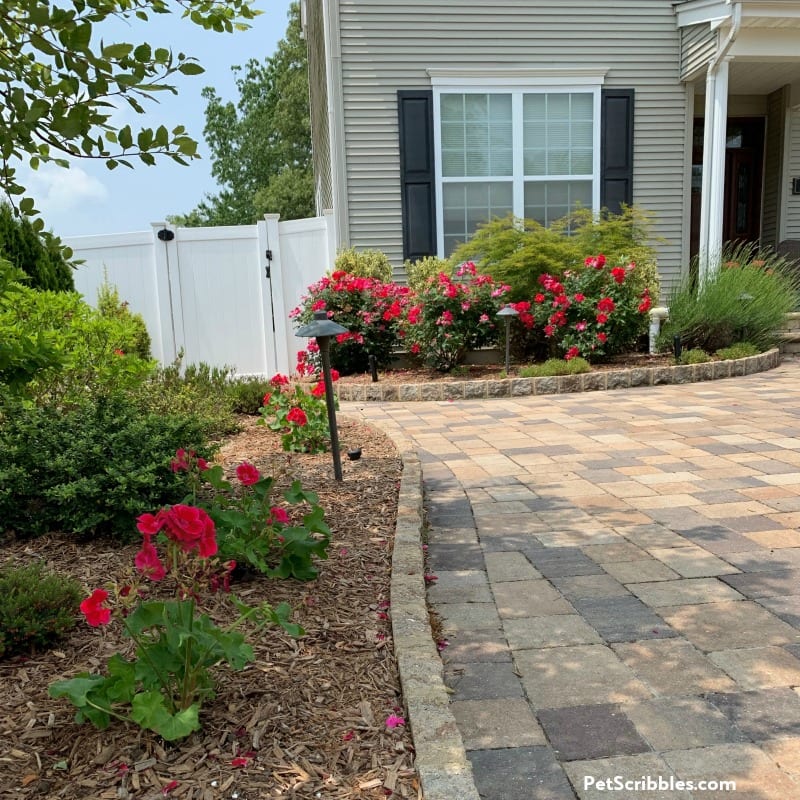
Our neighbors across the street complimented me on how colorful the gardens are, and I think it’s because I added these geraniums. I really do.
My love for simple annual geraniums!
The truth is, I’ve always loved geraniums.
I love their simplicity.
I love their reliability.
When I plant geraniums, I don’t worry about fussing over them to make sure they survive.
Geraniums always look good, and only get better as the Summer season continues.
I smile when I water them.
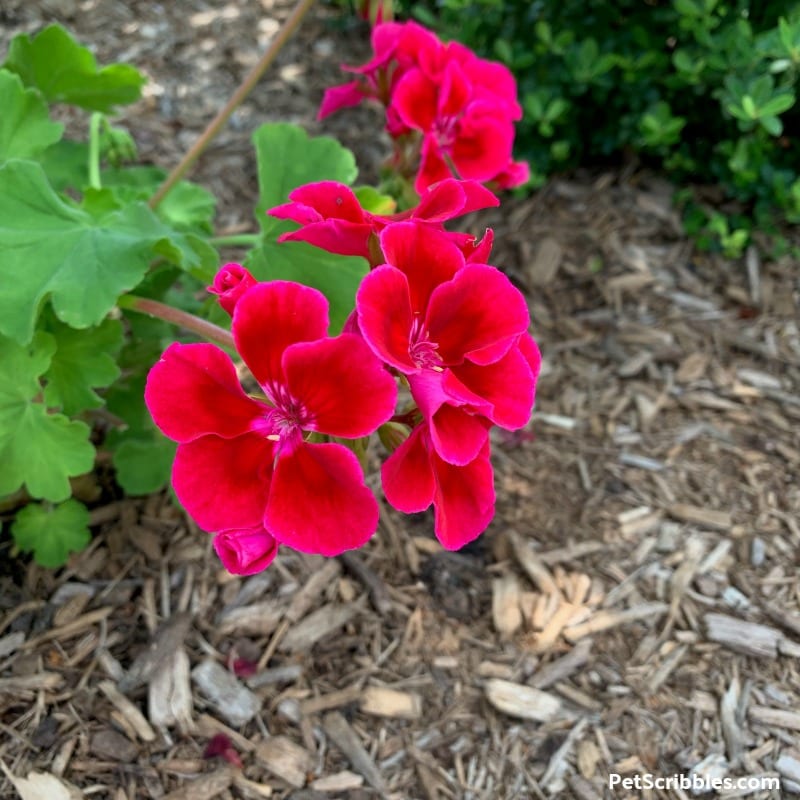
I dutifully trim off their dying stems and deadhead the old flowers — even though the dead stems and flowers can separate and fall off the plant on their own, eventually, without my help.
And when I snap off a yellowing leaf, it gives me a chance to inhale the spicy geranium fragrance.
Heck, I snap off the green leaves just to enjoy the scent!
Geraniums add instant pops of color to the garden, as I found out this season, and I’m in total love with the result!
Are geraniums annual or perennial plants?
It depends which geraniums you’re talking about.
You see, annual geraniums are usually called geraniums and sometimes called zonal geraniums.
However, these geraniums are actually not geraniums.
The true name of annual geraniums is pelargonium. The full name is Pelargonium hotorum.
Pelargoniums are related to perennial geraniums, which only adds to one’s confusion when shopping for geraniums, as most nurseries and garden centers now carry both zonal (annual) geraniums as well as perennial geraniums.
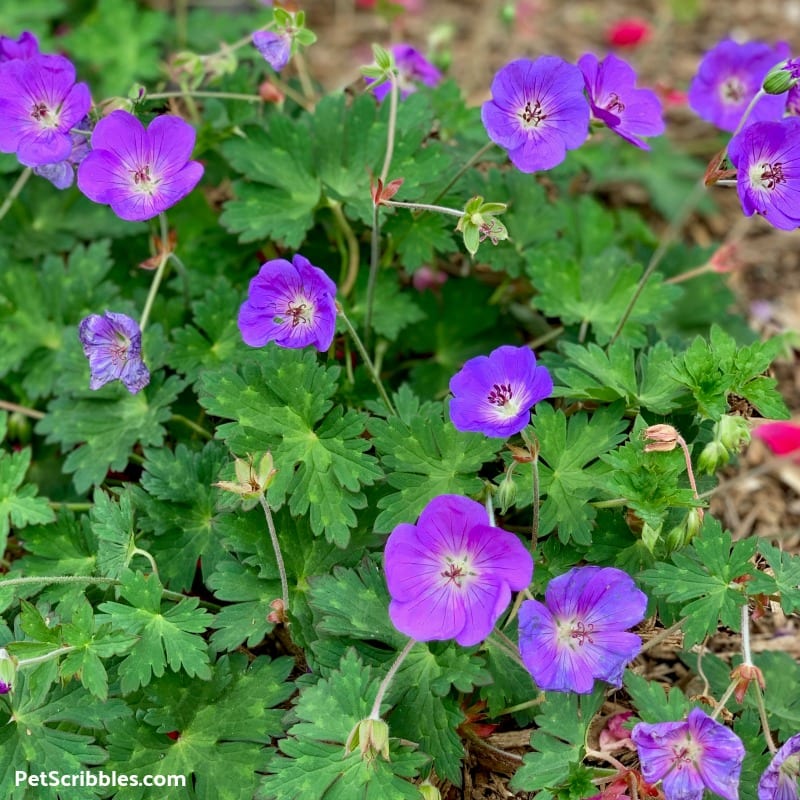
A short history about geraniums
The earliest history of geraniums dates back to pre-1600:
Most of the Pelargonium plants cultivated in Europe and North America have their origins in South Africa. … The first species of Pelargonium known to be cultivated was a native of South Africa. It was probably brought to the Botanical Garden in Leiden before 1600 on ships which had stopped at the Cape of Good Hope. In 1631, the English gardener John Tradescant the elder bought seeds from Rene Morin in Paris and introduced the plant to England. By 1724, several varieties had been introduced to Europe.
from Wikipedia’s entry on Pelargonium
The 1800s marked the height of Pelargonium popularity. In England, scented pelargoniums were grown in greenhouses, manor halls and cottage windows, and rose geranium oil became an inexpensive substitute for Attar of Rose (rose oil) in the French perfume industry.
from “Pelargoniums: An Herb Society of America Guide“
And how did Pelargoniums cross the pond to America?
Pelargoniums arrived in the U.S. with the early colonists. With “little access to spices,” scented pelargoniums were used by colonists as a flavoring for foods as early as 1818. Thomas Jefferson is said to have maintained a small collection at the President’s House. Scented geraniums were reportedly among the first houseplants “suggested as benefiting” from indoor lighting following Edison’s invention of the electric lamp in the late 1800s.
from “Pelargoniums: An Herb Society of America Guide“
For some very interesting reading with a cup of tea — on a rainy day when you can’t get outdoors to garden — click over to read Pelargoniums: An Herb Society of America Guide. It’s a 70-page booklet you can download for free — or read online — with everything from history to crafts to recipes. It’s an enjoyable and informative guide!
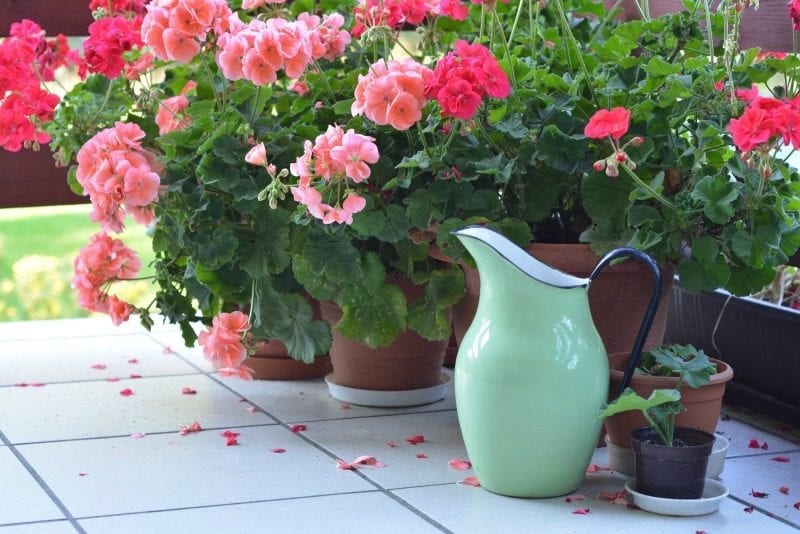
Do annual geraniums come back every year?
Although some annuals will come back every year because they easily drop their seeds back into your garden bed, annual geraniums will not return the following season. However, you can take cuttings of your geraniums to grow during the Winter season and plant the following Spring.
See cutting section below for tips.
Do geraniums bloom all Summer?
Yes. With just a bit of care on your part, annual geraniums will last the entire gardening season.
Depending on where you are located will determine how much care — or how little — your zonal geraniums require. If you’re gardening in Maine, for example, your geraniums won’t be baking in the hot sun like we have here at the New Jersey shore.
My gardening tips about geraniums in this guide are generalized for all USDA zones. You may or may not need to be concerned with all of them, depending on how happy your own geraniums are!
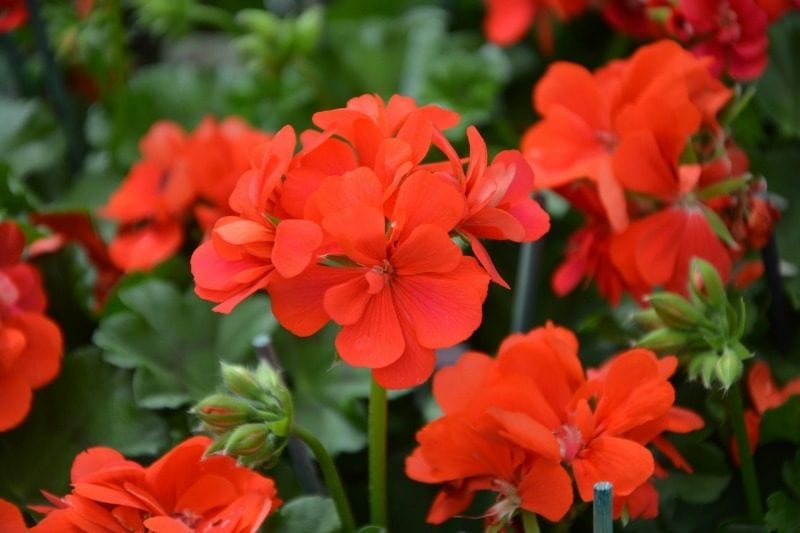
Are geraniums resistant to deer, rabbits and squirrels?
The answer depends on who you ask. Supposedly, the scent, taste and texture of annual geraniums are enough to strongly repel and deter deer, rabbits, squirrels and other rodents from being interested. However, if animals are hungry enough — or curious enough — they may nibble.
Just a few weeks ago, I found two chewed off flower stems laying next to one of our geranium plants. Obviously some type of critter tried them out and didn’t like them. Thankfully.
I think it was the rabbit who likes to play around in our garden bed. And I’m not kidding — we’ve watched this rabbit actually roll around in the mulch and take a snooze underneath some larger shrubs, before going back across the street to wherever his current abode is. I always think rabbits are so cute, until they do damage. Even then? I’m still a bit soft-hearted for them!
Annual geranium colors
Way back when, the most common colors of zonal geraniums were white, pink and red.
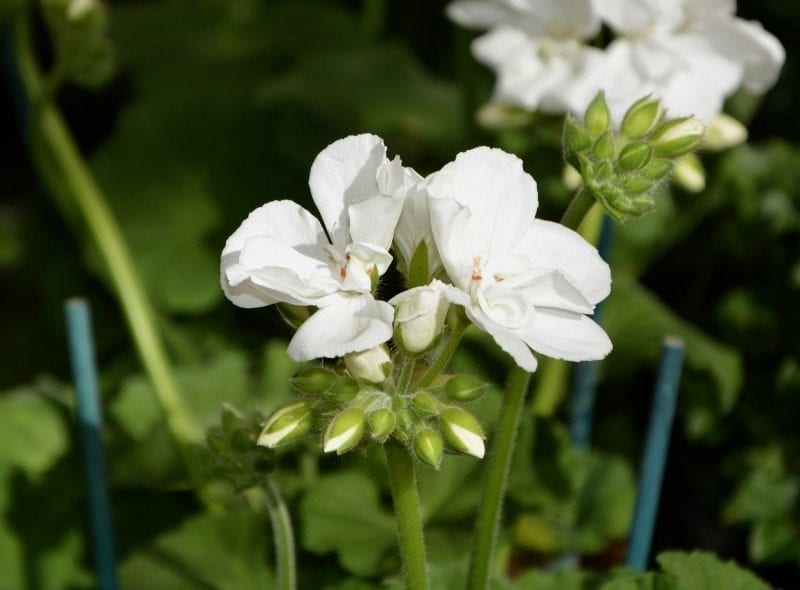
Fast forward to today, and these workhorses of the Summer garden come in every color imaginable, including peach and orange shades, rose and fuchsia colors, yellows, pale purples, deep magentas, and various pinks, reds and of course white.
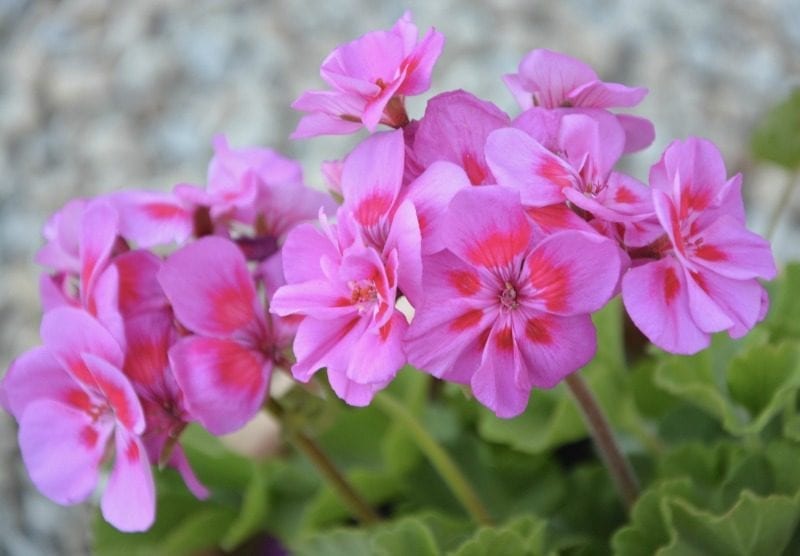
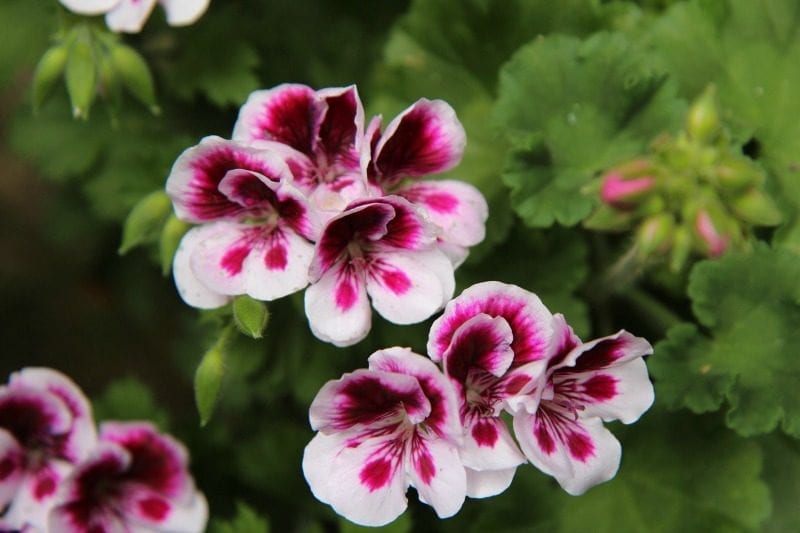
Do geraniums prefer sun or shade?
Geraniums love growing in full sun, although they might need some partial shade in the southern United States.
Even here at the Jersey shore area, my own geraniums are definitely baking in the full Summer sun. They are blooming their hearts out — just as the ones which get some partial shade each afternoon in my garden beds — but their leaves appear to be an every-so-slightly lighter shade of green.
It’s interesting to observe.
Annual geraniums — watering requirements
Whether you are growing annual geraniums in pots or in the ground, allow the top of the soil to dry out in between waterings. Most experts suggest the soil should feel dry one inch down from the surface. Geraniums can tolerate some drought.
Annual geraniums — too much water
What happens if there is a prolonged amount of rainfall?
We’re having just that issue this week here at the Jersey shore, with heavy rain happening every night. (Darn nature!)
Here’s what might happen to your geraniums when there’s too much water, and what you can do to help them out . . .
Geranium leaves turning red
Here’s what some of our geranium leaves currently look like, after having so much rain:
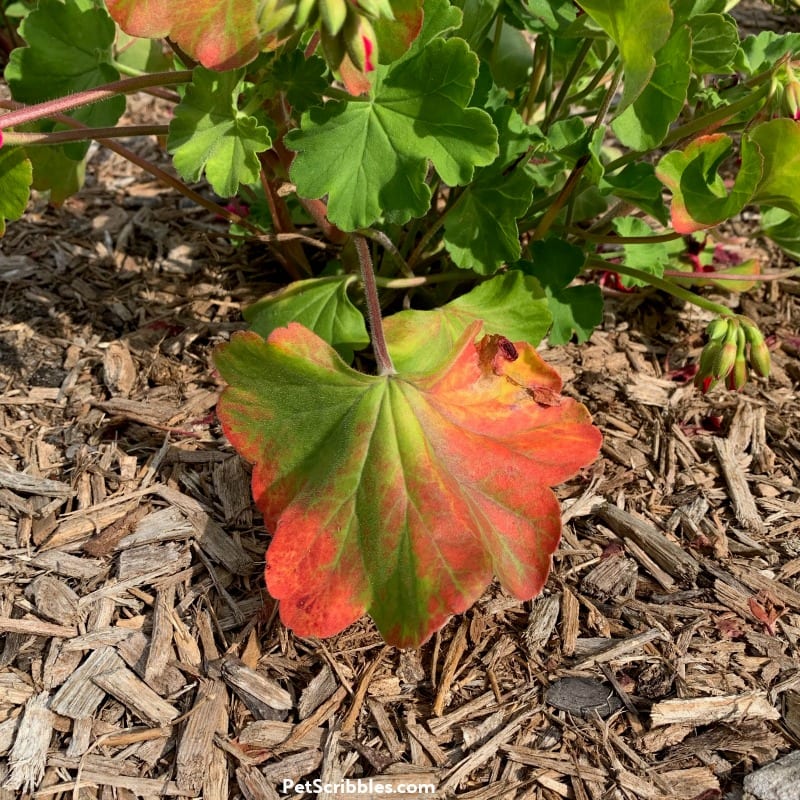
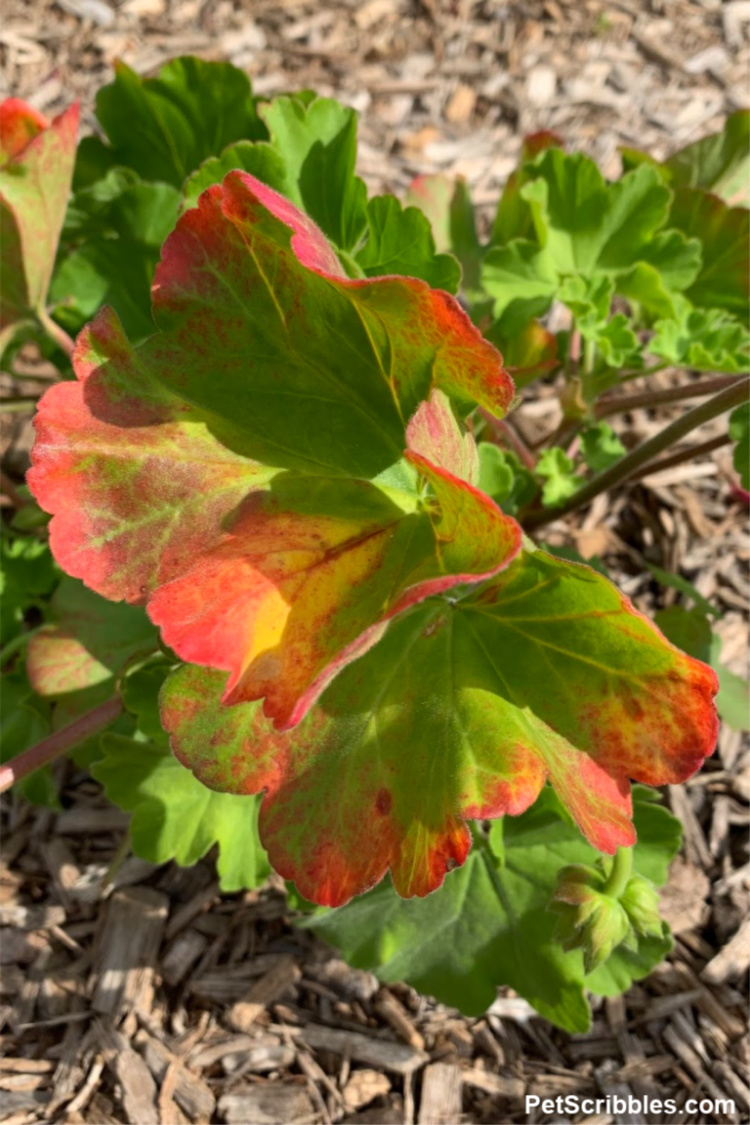
When annual geranium leaves turn red, it means the plant is stressed in some way. In our case it’s definitely from too much water.
Red leaves can also signal a phosphorus deficiency. Try feeding the plants with a water-soluble fertilizer more regularly.
Snip off the affected red leaves, and hopefully sunnier days will help the geranium recover.
See Pruning section below for tips.
Geranium leaves turning yellow
If the leaves begin to turn yellow, it means almost the same thing as the leaves turning red: the plant is stressed. Again, it can be from too much or too little water, and possibly a lack of nutrients in the soil.
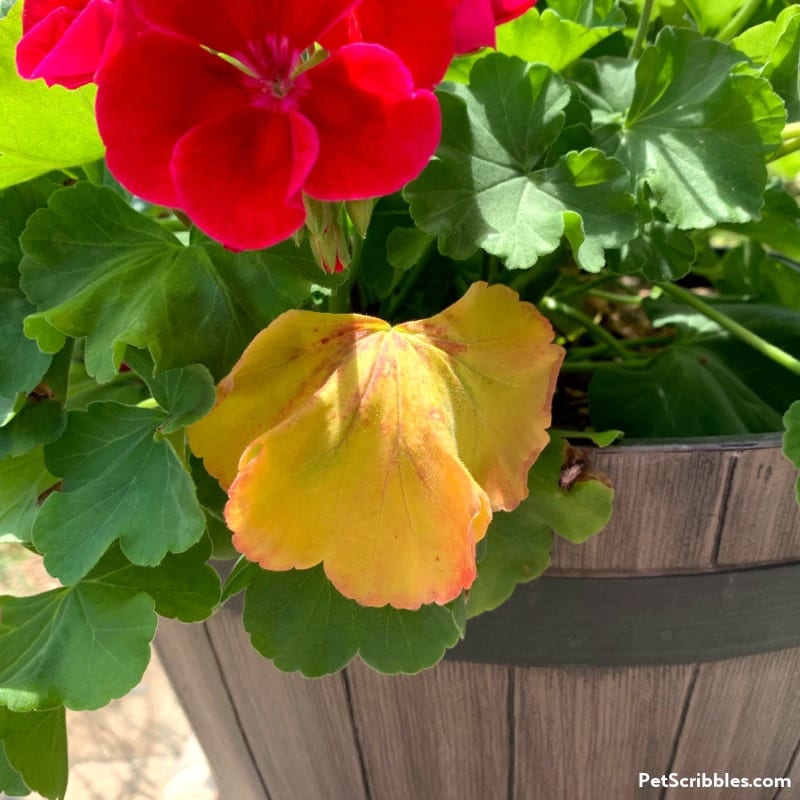
Snip off the yellowing leaves, ease up on watering and also fertilize.
See Pruning section below for tips.
Geranium flowers looking moldy
If you notice any of the geranium plant’s flowers getting moldy when there’s a lot of rainfall, remove those entire flower heads immediately. Cut them off at the base of their stem. It could be something called “botrytis” mold, and it is not fun. Removing whatever you can from the plant may prevent this mold from spreading.
(And I’m so glad I don’t have any examples from my own garden to show you! So far, so good!)
To see a list of other possible diseases that affect annual geraniums, check out this helpful list of Geranium Diseases from Penn State.
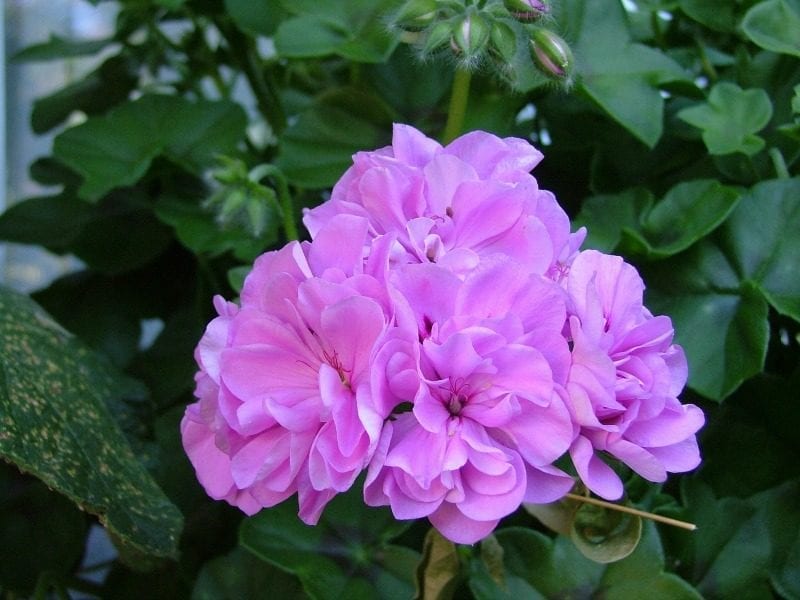
Best fertilizer for geraniums
I add Espoma Plant Tone into each planting hole when adding new plants to my garden beds or containers. It’s a slow-release fertilizer that keeps the plants happy all Summer long.
Here’s what the bag looks like, if you’re looking for it at a garden center or home improvement store:
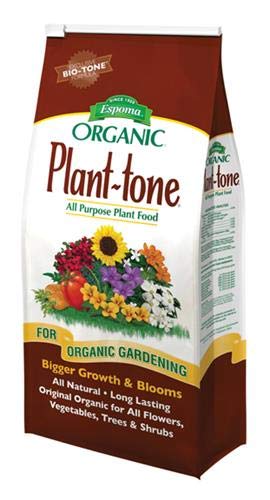
You can also use a fertilizer that is mixed with water, with many brands sold widely at home improvement stores and garden centers. Miracle-Gro is a familiar example. Many of these fertilizers require more frequent applications, so be sure to follow the product’s instructions.
How to deadhead geraniums
I use Fiskars Pruning Snips for easy tasks like deadheading geraniums:
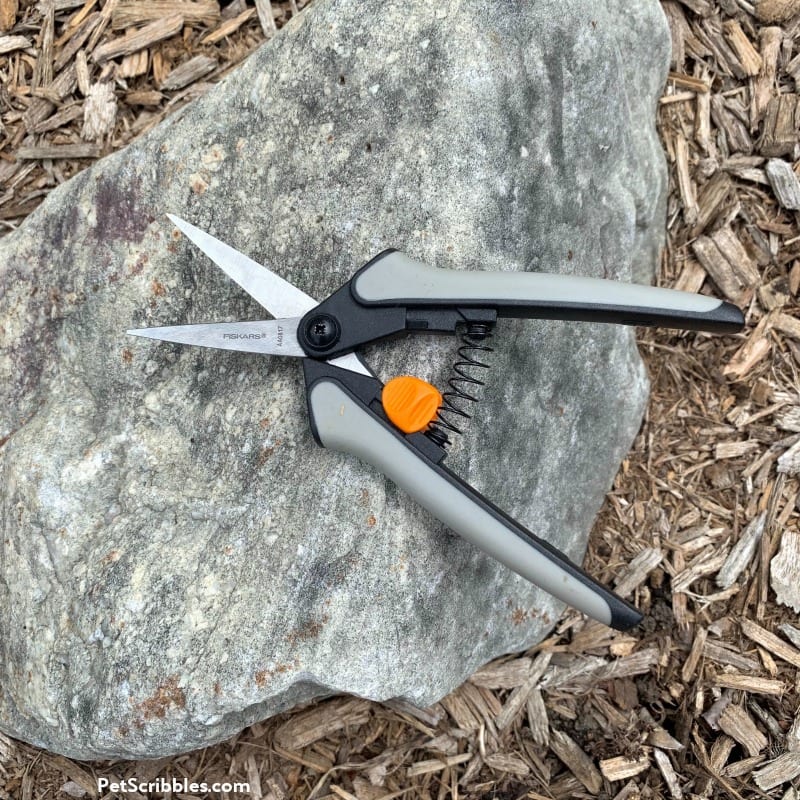
I find them to be easy on the hands and they make clean cuts.
I also like the little safety cap that comes with these pruning snips:
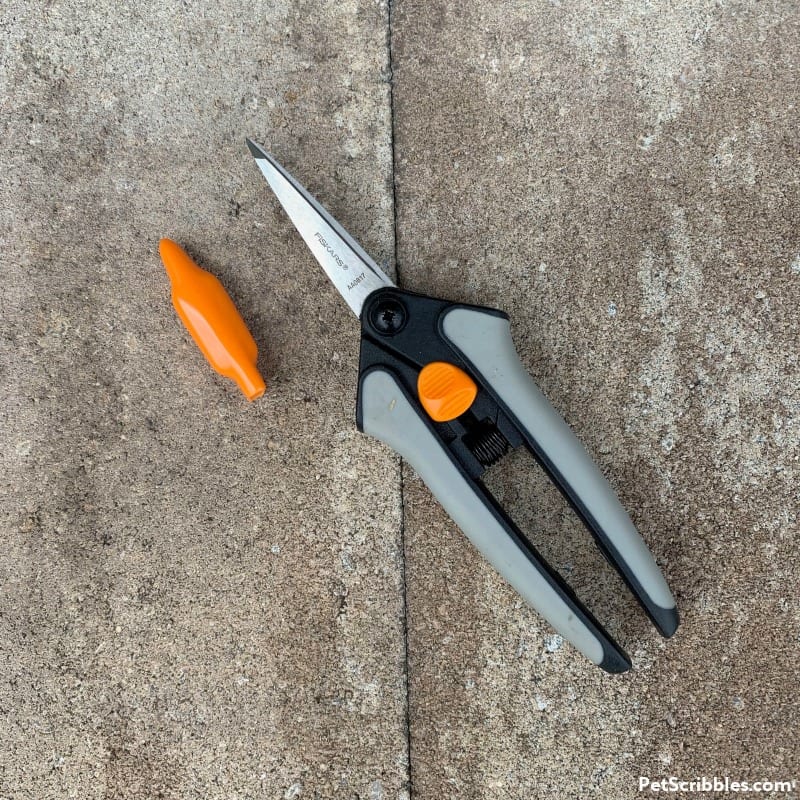
Deadheading annual geraniums is easy to do.
The spent blooms are easily recognizable:
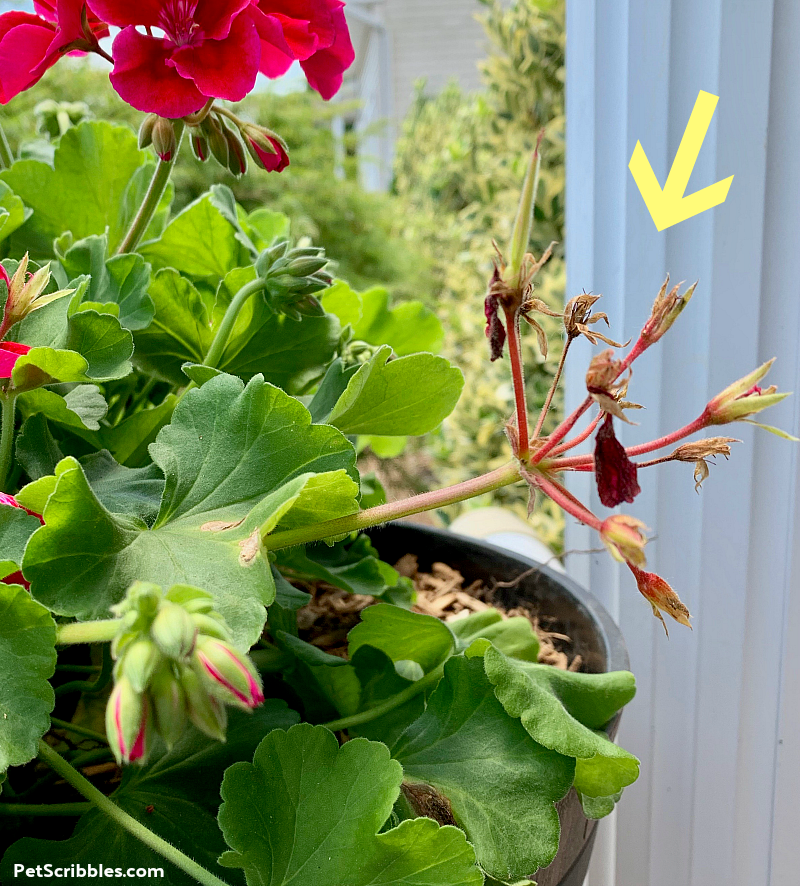
If you just snip off the dead flower heads, you will soon be left with a brown stem sticking out of your plant.
I prune the dying or dead blooms far down along their stem — as far as you can go.
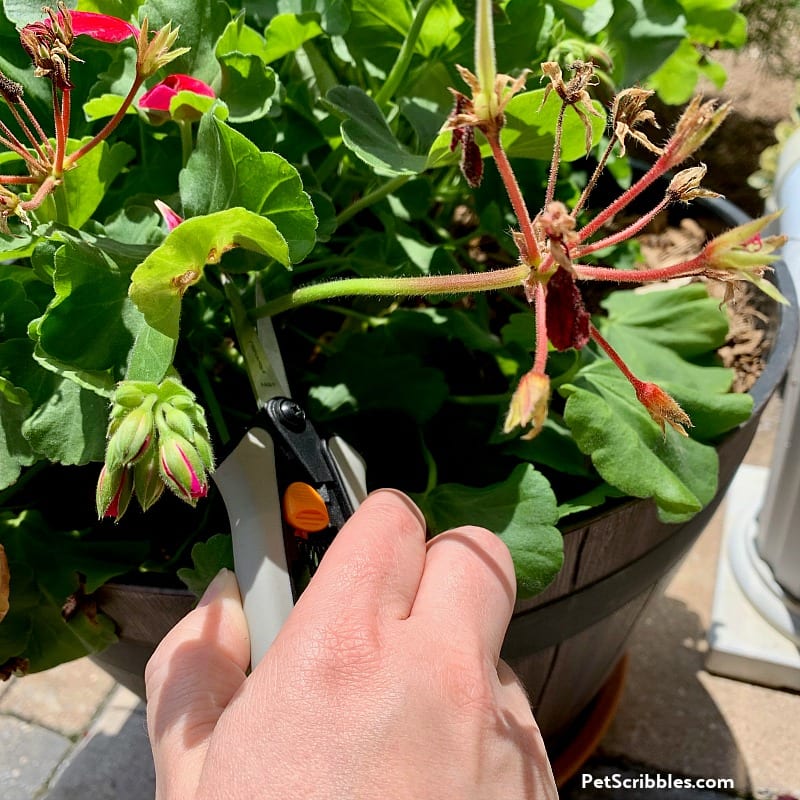
The base of the stem is usually hidden by the geranium’s leaves. Move those leaves gently with your free hand while snipping off the stem.
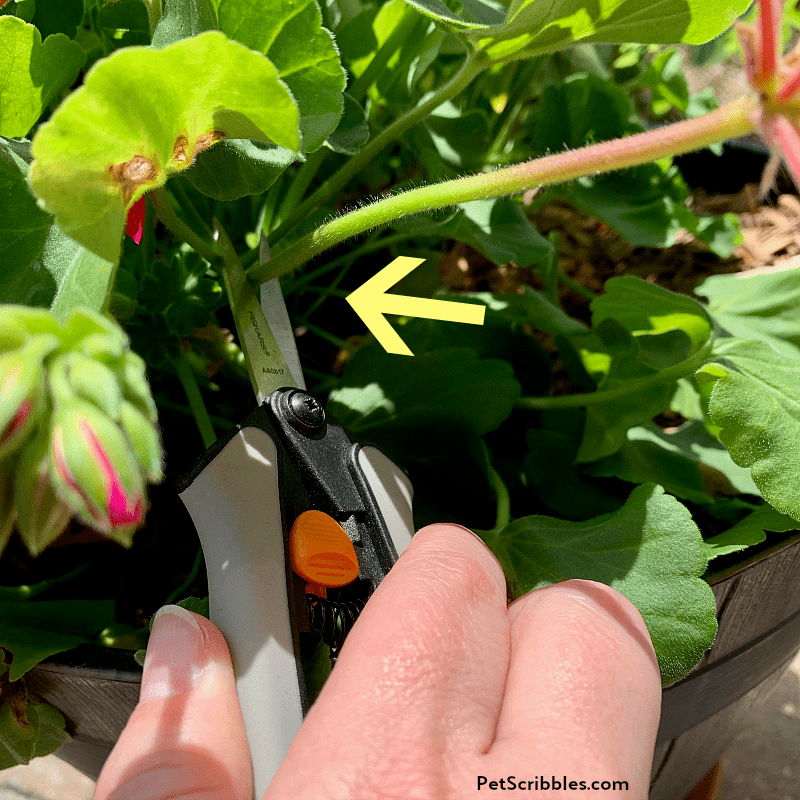
Remember: The more you remove the spent blooms, the more new flowers your geraniums will produce!
Pruning geraniums
Pruning zonal geraniums for shape and size
Pinching or pruning geraniums during the start of the growing season can make the plant more bushy and full.
If you prune off the tops of the plants, you will encourage the plant to produce more leaves and new growth around the base for a more compact, bushier looking plant.
If you prune off the bottoms of the leaves around the base, you will encourage more growth vertically for a taller looking plant.
Try both ways to have varying heights in your garden beds and containers.
How to prune geraniums for shape and size:
- Pay attention to the plant’s stems.
- Once a stem has grown a couple of inches or more, prune off the rest of that stem, by snipping with garden scissors or pruners, leaving at least two inches of that stem.
- You can also pinch back the stem with your fingers.
- Soon, that stem will sprout two new stems off the original area where you cut it back.
- Use this same procedure to remove any spent blossoms or leaves that are dying or getting leggy throughout the Summer season.
Pruning discolored and dying leaves from zonal geraniums
I walk through the garden at least once a day to tidy up my annual geraniums. It’s a very quick thing to do, and so satisfying to see them looking good.
Keep your garden snips handy to remove any dying leaves.
Removing red or reddish leaves from geraniums
Here is one of my geraniums after the horrible rains we had, with the tell-tale reddish leaves:
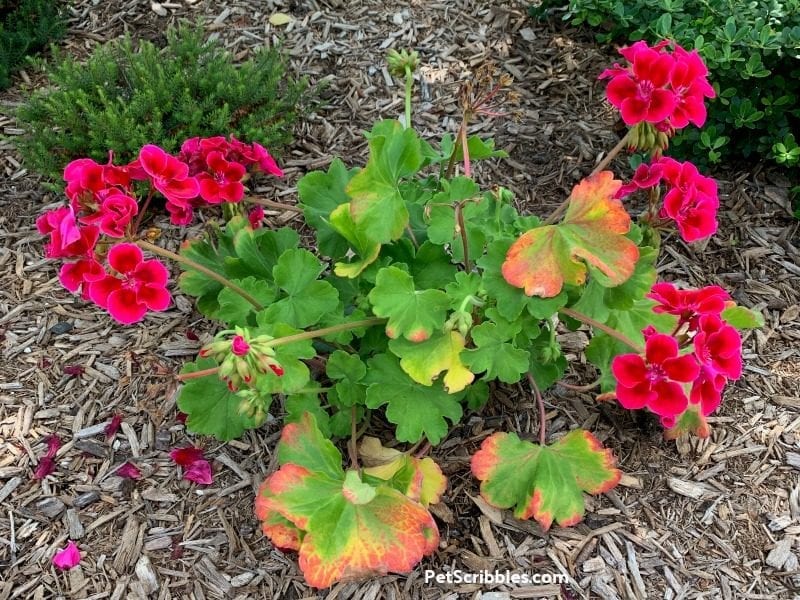
Using my garden snips, I find the part of each reddish leaf’s stem that is closest to the main plant stem, and simply cut it off.
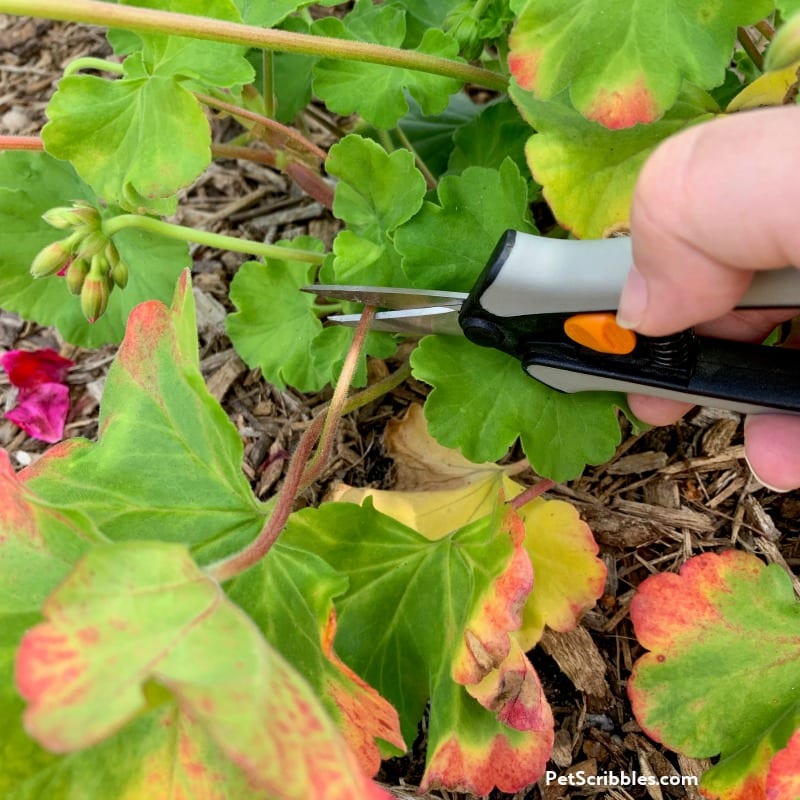
This geranium looks so much better after just about one minute of effort.
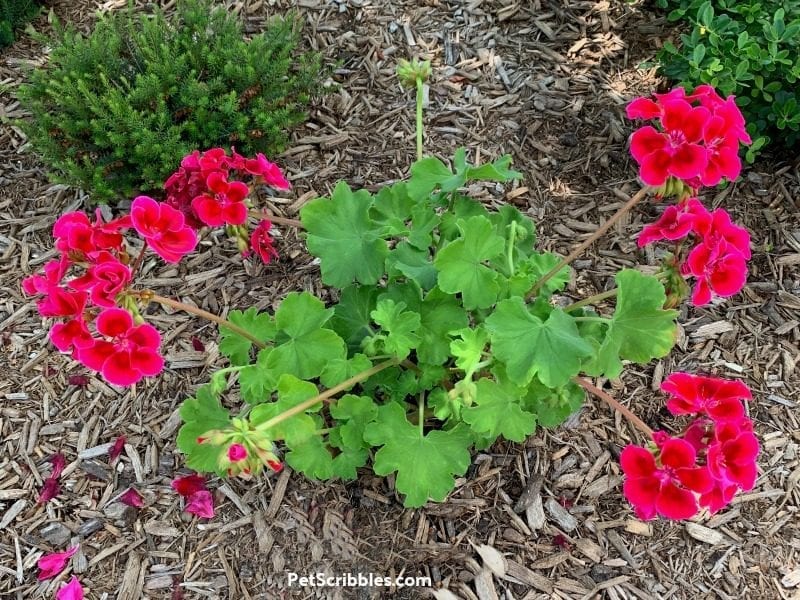
Removing yellow leaves from geraniums
The most common issue with zonal geranium leaves are yellowing or fully yellow leaves.
In many cases, these leaves will come off easily by gently pulling or pinching them off with your fingers.
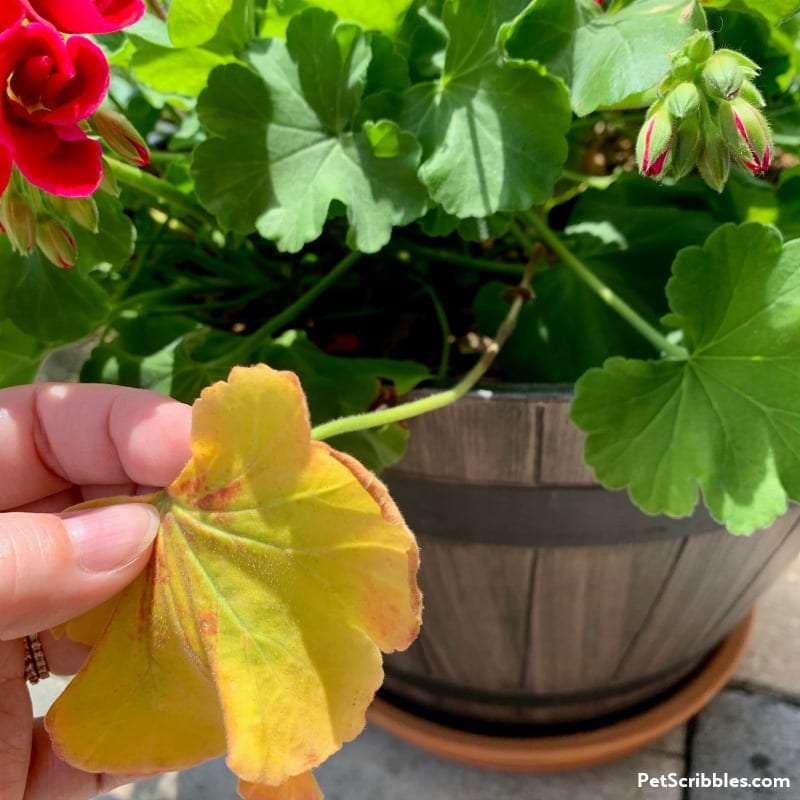
If the leaf doesn’t come off after a gentle tug, use your snips.
Removing dying or diseased leaves from geraniums
Any time you see green leaves with signs of decay or disease, promptly remove them as well.
It doesn’t take long at all to help your geraniums look their best.
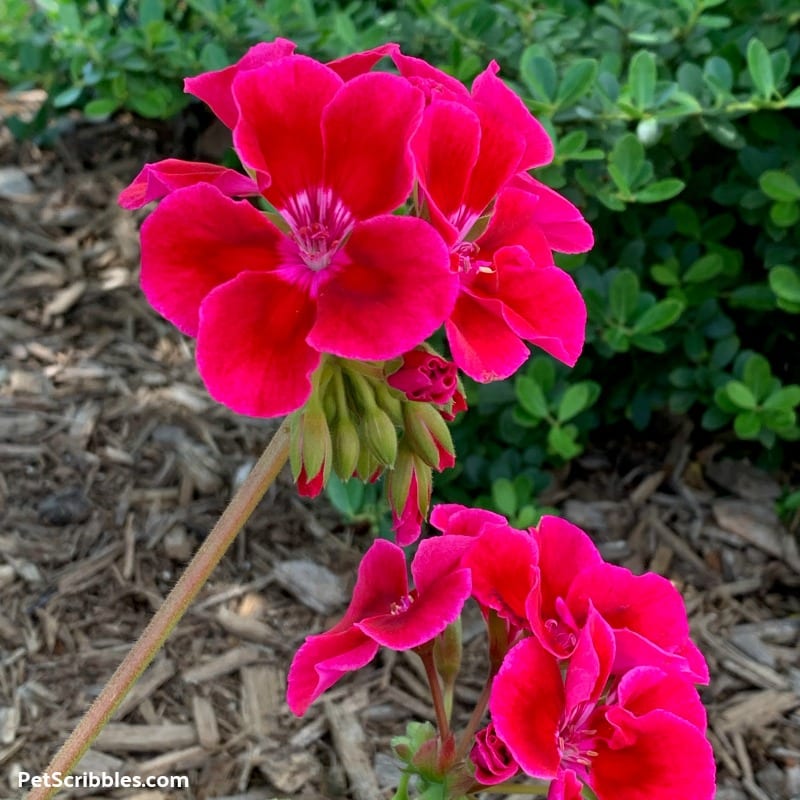
How to grow annual geraniums from seed
Can you grow geraniums from seed?
Yes, you can grow geraniums from seed, however cuttings are a much faster way to propagate your favorite geranium plants.
Here’s what you need to know if you want to grow geraniums from seed:
First, starting geraniums from seed is a very slow-growing process. If you want to start your geraniums from seed with plans to plant them in the ground in the Spring, you need to start your geranium seeds in late-January to mid-February.
Second, you can never be truly sure that you’re getting the correct seeds when you purchase those packets at the store. For many gardeners, this isn’t a big deal, but if there are any labeling errors or other seeds accidentally mixed in — and you’re wanting a very specific geranium type and color — you may be in for a surprise when the seedlings grow and begin to flower.
Just keep these two points in mind, and like I said — for most gardeners, it isn’t a big deal.
The best way to sow geranium seeds, from The Herb Society of America:
If you decide to take your chances and propagate from seed, HSA Pelargonium experts Caroline Amidon and Joyce Brobst have the following recommendations: Bury seed about 1⁄4 inch under soil, a little more or less depending on the size of the seed. Lightly cover with a piece of glass or plastic or use a growing tray with a plastic top. Soil should be kept moist, and seeds should remain covered until germination, after which the cover can be removed. Caroline and Joyce don’t suggest planting seeds directly in the garden. True species seeds are “too difficult to get” for the uncertainties of a garden planting, and as Joyce points out, “If you acquire seeds you want to know exactly where they are.” If collecting seed from existing plants, seeds can be harvested after flower carpels brown by drying the carpels in a paper bag for a few days.
from “Pelargoniums: An Herb Society of America Guide“
Things you need to know when growing geraniums from seed:
- Seeds must be started indoors, never sow directly into the ground outside.
- The seeds usually take one to two weeks to germinate, sometimes longer.
- Keep the seedlings near a bright, south-facing window or under grow lights.
- Flowers will appear in approximately 3 to 4 months.
- Pay close attention to the information on your seed packets, as each geranium type is different and some have earlier or later bloom times.
How to grow annual geraniums from cuttings
You can grow new geraniums from cuttings, as they root easily.
Rooting hormone is not really needed, as geraniums root fairly easily without it. However, some people swear by rooting hormone as helping plants root well.
How do you start geraniums from cuttings?
Cut a stem from the geranium between 4 inches to 6 inches in length.
Be sure to choose a stem that is not flowering.
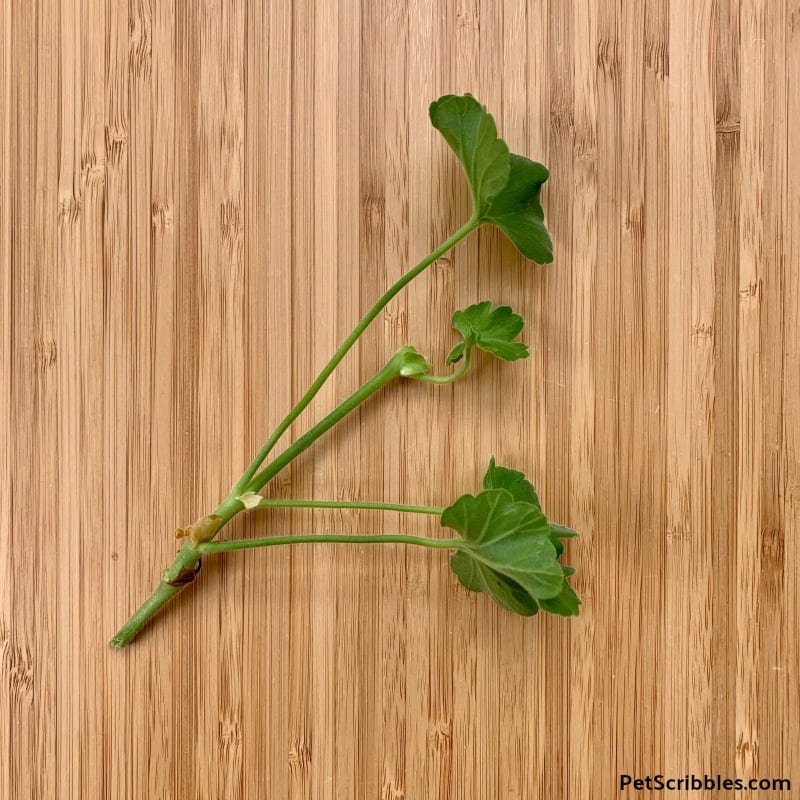
The cutting should have one leaf at the tip — remove all other leaves using garden snips:
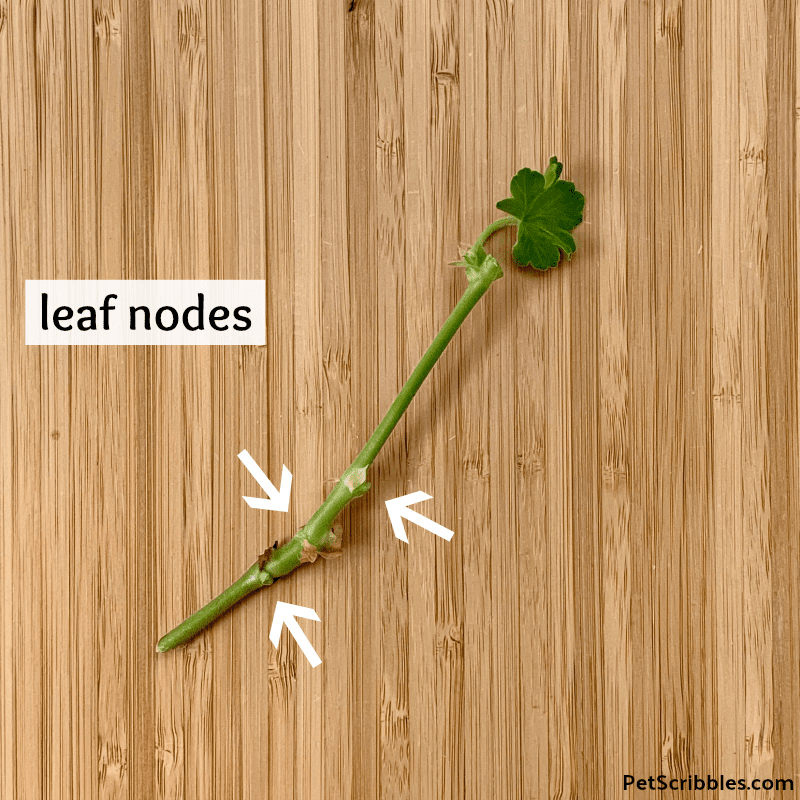
Leave at least two nodes on the cutting. Those nodes will go into water or soil — the two primary methods of propagating geraniums — to begin rooting.
Once the cuttings have rooted and are growing…
You can cut the top leaf off, as this will encourage two new stems to form from the single base stem, and encourage a bushier growing habit.
Remove any flower buds that begin to form, as you want the plant’s full energy concentrated on growing the plant stems, roots and leaves.
Can you root geranium cuttings in water?
Yes. Stick the geranium cuttings into a glass or jar of water. Place the glass near a sunny window but don’t place it in full sun.
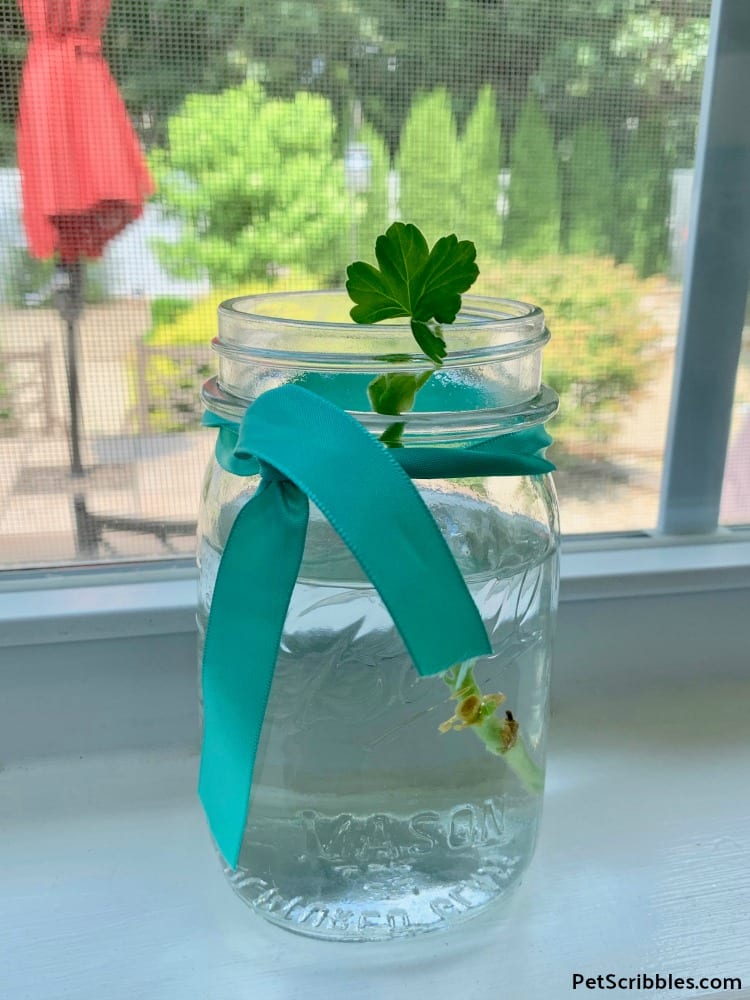
How long does it take for geranium cuttings to root in water?
Geranium cuttings in water can root in approximately one month.
Can you root geranium cuttings in soil?
Yes. Stick the cuttings (described above) into soil using small pots.
How long does it take for geranium cuttings to root in soil?
Geranium cuttings in soil can root anywhere from one week to one month later.
The best “how to” that I’ve seen for rooting annual geraniums in soil is by Pamela of The Flower Patch Farmhouse. You can read her post — which includes a helpful video — by clicking here.
Winter care for annual geraniums
Can you keep a geranium in the Winter?
Yes, it’s quite common to bring your potted geraniums inside for the Winter season.
And if your geraniums are planted in a garden bed?
You can dig them up and plant them into a pot.
- Prune the plants back by approximately one-third.
- Water well.
- Place your potted geraniums in a cool but well-lit room for the Winter season. Placing them in a sunny window is perfect.
- Keep them on the dry side. Too much water during the Winter months could end up making the plants rot.
Before placing your geraniums back outside in the Spring, prune them down well, especially if there has been growth during the Winter season. They will begin growing and becoming nice and full in no time at all.
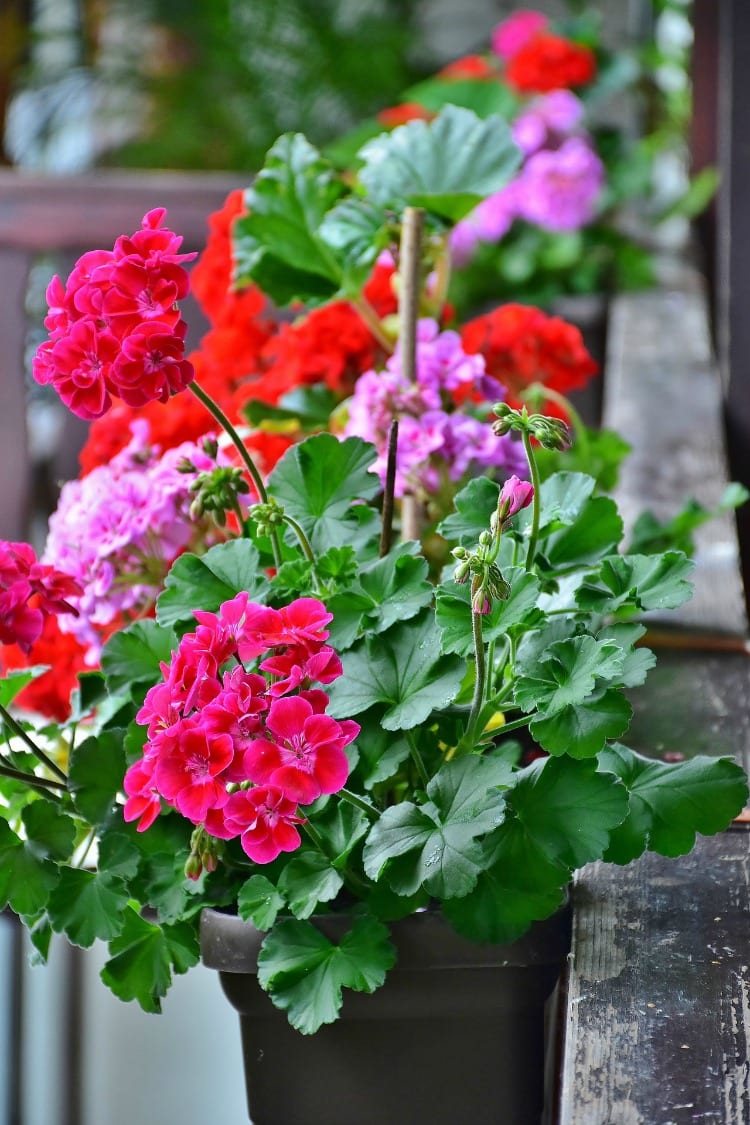
I hope this guide will help you care for your annual geraniums.
I’m looking forward to your feedback, comments and questions.
Happy gardening!

I can’t tell you how happy I was when I saw this email. I love geraniums too. When I first buy them they are just beautiful. Then as time goes by, they start to get that red leaf and more of the yellowing leaf. I thought the yellowing had to do with watering. But anyway, I’ve never found a good simple explanations for the geraniums and all about them. Your blog was just what I needed. Thanks! I also live in South Jersey.
Thanks SO much for your feedback, Irene! I really appreciate it. Hopefully this will help gardeners who run into these issues. I hope you can stay cool during this horrible heat wave we’re having here in South Jersey. A heat index of 110 degrees today? Ugh!
Thank you for your excellent and very complete article. I fell in love with geraniums while visiting Paris, where apartment window boxes are overflowing with thriving examples. Like the commenter above, my geranium leaves are turning red and yellow. I am wondering if too much sun could be the culprit since the problem began after I moved them out of a less sunny area into one with a lot of Southern California late morning/afternoon sun because in the shadier spot they seemed to have stopped blooming (although the leaves were nice and green). Any light (!) you can shed on the subject would be so appreciated! Thanks.
Hi Anita — those Paris apartment window boxes sound lovely! As for your leaves turning red and yellow… it happens when the plants get stressed. It’s possible that just moving them stressed them a bit — but — they love sun, so I think they will appreciate the sunlight now. Snip off the red and yellow leaves, and apply a slow-release organic fertilizer like Flower-tone by Espoma…or something similar. (Try and stay away from the chemical ones like Miracle-Gro. Those just push out fast growth and don’t really help the plant and soil long-term.) It’s possible your geraniums just need a bit of nutrient food (fertilizer) and after watering them in, let them settle into their new sunny spot. Give them a couple of weeks before worrying. Even too much rain can cause the leaves to be red and yellow — which is what happened in my own situation that I showed in the photos. I hope this helps! Keep me posted!
Thank you, Laura! Hugely helpful. I will do as you suggested. I already had snipped off most of the red/yellow leaves and haven’t seen any more since, so I’m sure you are right and it was the trauma of changing location (and repotting at the same time, forgot to mention that little detail!) that caused the problem. Thanks, again. I’ll let you know how things evolve.
Glad to hear it Anita, and hope the geraniums bloom their hearts out for you this year!